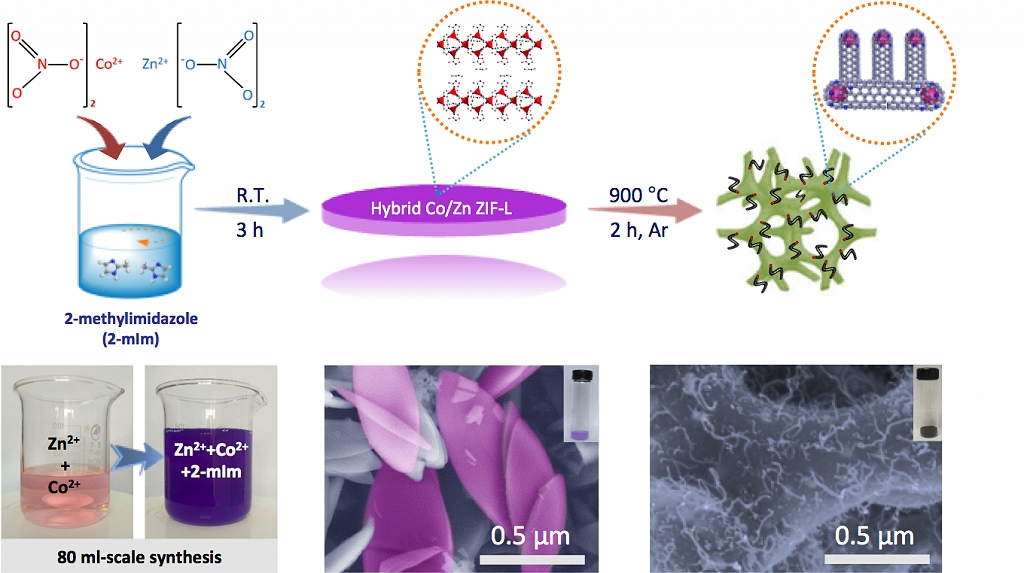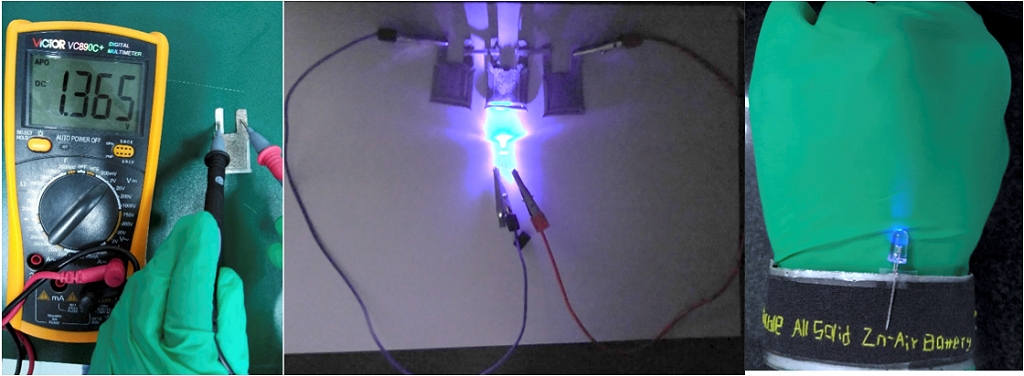겐트대학교 Francis Verpoort 교수, 충전성 아연-에어전지를 위한 초고전기화학특성의 ZIF 에어전극 개발
Prof. Francis Verpoort, email: francis.verpoort@ghent.ac.kr
환경오염과 에너지부족을 해결하기 위해서는 청정에너지 개발과 효율적인 에너지 저장이 필요하지만 이 부분은 여전히 어려운 과제로 남아있다. 아연-에어전지는 에너지 밀도가 높아 전기자동차의 전력원으로 해당되는 에너지 저장고로 촉망받고 있는데 그 이유는 에너지 저장 및 변환의 과정에서 산소 환원 (ORR)과 산소 방출 (OER)이 매우 중요한 사안이어서 백금, 이리듐, 루테늄과 같은 금속들이 산소 환원과 산소 방출에서의 전기 화학적 촉매로 사용된다. 하지만 비싼 비용과 낮은 안정도가 아연에어전지의 상업화를 방해하고 있어, 전통적인 금속 촉매를 대체 할수 있는 저비용이면서 안정적인 이관 성능을 가진 전극 재료를 개발하는 것이 관건이다. 이와 관련하여 겐트대학교 글로벌캠퍼스 Francis Verpoort 교수 연구팀은 Mu Shichun 교수 연구팀과 협력해서 충전 가능한 아연에어전지를 위한 이차원 듀얼 금속 ZIF로부터 파생된 초고전기화학적특성과 이관성능을 가진 에어전극을 개발했다.
단일 전구체인 이중 금속 ZIF-L의 열분해를 통해 훌륭한 이관성 입증 된 에어전극인 Co가 들어있는 질소-도핑 탄소나노튜브 (Co-N-CNTs) 캡슐이 형성된다. 흥미롭게도 열분해 후에 질소는 CNT의 팁을 가로 질러 코발트와만 공존한다. 따라서, 활성 부위로서 풍부한 Co-N-C 부분이 CNT의 표면에 완전히 노출됨으로써, 이는 향상된 전기 촉매 특성에 유익 할 것으로 추측된다. 결과적으로, Co-N-CNT는 시판되는 Pt/C와 IrO2 및 대부분 보도된 금속-유기물 프레임 (MOF) 유래 촉매에 비해 ORR 및 OER에 대한 우수한 전기 촉매 활성과 안정성을 나타낸다. 1차 전지는 1.365V 의 높은 오픈 전압, ~90 mA cm-2의 전류 밀도, ~101 mW cm-2의 피크 전력 밀도 및 우수한 안정성 (15시간의 130 사이클 충전-방전 퍼포먼스)을 나타냈다. 특히, 나노 소재는 기타 최첨단 응용분야에도 유용 할 것으로 예상된다.

그림 1. 하이브리드 Co/Zn ZIF-L 및 Co-N-CNT의 제조과정 (상). Co / Zn (1 : 1) 하이브리드 ZIF-L 80 ml 규모의 합성 (하좌). Co/Zn (1:1) 하이브리드 ZIF-L SEM 이미지 (하중). Co-N-CNT 사진 (하우)

그림2. 전류 전압계로 쟀을 때 최소 1.365 V의 전압을 나타내는 아연에어전지 사진 (좌). 세 개의 아연에어전지를 직렬 회로로 연결했을 때 초록색 불이 켜진 LED (5mm, ~3.2 V) 사진 (중). 세 개의 충전성 아연공기전지를 직렬 회로로 연결해서 만들어진 팔찌를 이용해서 LED에 초록색 불이 켜지도록 함(우).
참고자료:
Advanced Functional Materials (2018) DOI10 (.1002/adfm.201705048
원문:
Title: Two-dimensional dual-metal ZIF derived bifunctional air electrodes with ultra-high electrochemical properties for rechargeable zinc-air batteries
In order to find solutions for the increasing concerns of environmental pollution and energy shortages, development of clean energy and effective energy storage are highly demanded and are still major challenges for sciences and society. Zinc-air batteries have been suggested to be a promising energy storage system applicable as a power source for electric vehicles thanks to their high energy density. In the process for energy storage and conversion, the oxygen reduction reaction (ORR) and oxygen evolution reaction (OER) are the critical reactions, in which precious metals such as Pt, Ir, Ru, etc. all have been used as high-active electrocatalysts for ORR and OER, respectively. However, their high cost and poor stability are hampering commercialization of Zn-air batteries.
So the most notable challenge is to develop low-cost, highly active and stable bifunctional electrode material to replace the traditional precious metal catalyst. In this context, the research group led by Prof. Francis Verpoort in collaboration with Dr. Shichun Mu’s group developed two-dimensional dual-metal ZIF derived bifunctional air electrodes with ultra-high electrochemical properties for rechargeable zinc-air batteries.
The pyrolysis of the dual-metal ZIF-L as a single precursor resulted in Co nanoparticles encapsulated into nitrogen-doped carbon nanotubes (Co-N-CNTs) which demonstrated to be the excellent bifunctional air electrodes. It is interesting that after pyrolysis the nitrogen only coexists with cobalt across the tips of the CNTs. Thus, abundant Co-N-C moieties as active sites are fully exposed on the surface of CNTs, which would be beneficial to the enhanced electrocatalytic properties. As a result, the obtained Co-N-CNTs present superior electrocatalytic activity and stability towards ORR and OER over the commercial Pt/C and IrO2 as well as most reported metal organic frameworks-derived catalysts, respectively. The primary batteries exhibited a high open current potential of 1.365 V, a current density of ~90 mA cm-2 and a peak power density of ~101 mW cm-2 as well as good stability (130 cycles for 15 h charge-discharge performance). Furthermore, it is anticipated that our nanomaterial will also be useful for other cutting-edge applications.

